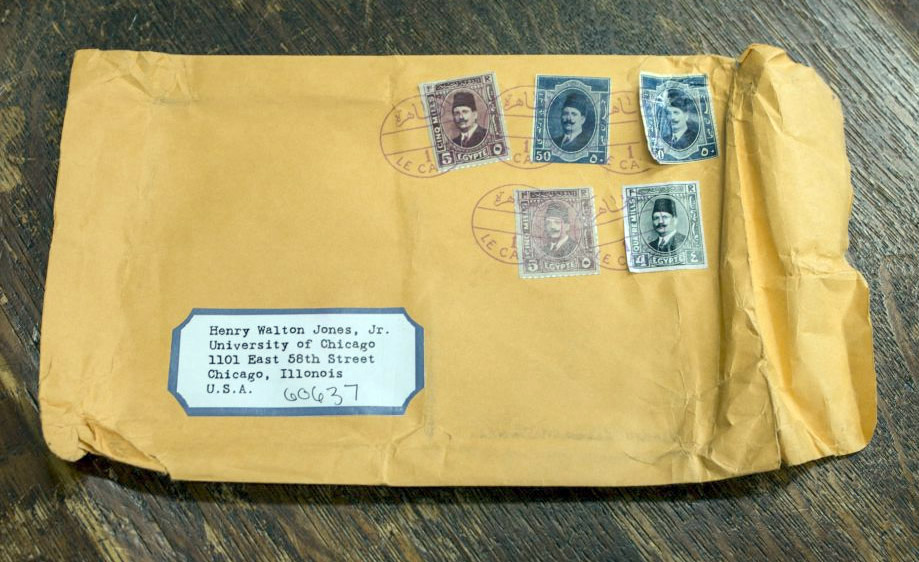Raiders of the Lost Journal

In the 1920s, an Egyptologist named Abner Ravenwood began recording his research in a journal. He drew maps, attached documents, and wrote idle thoughts in the book, hoping that together, the information he amassed would help him find a long-lost artifact. When he died in 1936, he left it in the care of a colleague — a university professor named Henry Walton Jones, Jr., who taught in the archeology department at the University of Chicago.
Fast forward a few generations to December 2012 and the journal reappeared in the mailroom at the very same University of Chicago, as seen above. There was only one problem: the University had no record of a Henry Walton Jones, Jr. teaching there or enrolled as a student. It took a few days, but the mailroom finally realized why: Henry Walton Jones, Jr. didn’t exist. He never did — at least not in real life. You’ve heard of him, though: he’s best known as Indiana Jones, the movie character.
Indiana Jones made his movie debut in the 1981 film “Raiders of the Lost Ark.” Jones, following in the footsteps of his similarly-fictional mentor Abner Ravenwood, searches for the lost Ark of the Covenant. He has a head start because Ravenwood, who had spent more than a decade searching for the same, had kept meticulous notes in the form of a journal, which Jones had in his possession. The rest of the movie’s plot isn’t important for our purposes, but if you haven’t seen “Raiders” yet, you probably should fix that regardless.
In any event, props from movies typically don’t get mailed to their fictional addresses, so administrators at Chicago were amused when this one arrived. They reached out to Lucasfilm, the makers of the Indiana Jones movies, likely to inform them that sone from their prop department pulled off a funny little prank. Lucasfilm investigated the matter and found that whatever came in the mail, it wasn’t the from the prop room. A Lucasfilm rep old Wired “we don’t know where the package came from but would love to know [too].”
The university decided to continue the investigation. The Chicago admissions office (which for some reason was the department put in charge of the matter) was stumped, so they asked the Internet for help. They posted the backstory and a plea for help, below, to their Tumblr account:
If you’re an applicant and sent this to us: Why? How? Did you make it? Why so awesome? If you’re a member of the University community and this belongs to you or you’ve gotten one like it before, PLEASE tell us how you acquired it, and whether or not yours came with a description– or if we’re making a big deal out of the fact that you accidentally slipped a gift for a friend in to the inter-university mail system. If you are an Indiana Jones enthusiast and have any idea who may have sent this to us or who made it, let us know that, too.
Toward the end of the post, the school announced that they set up a special email address in case anyone had any information about this mysterious piece of mail. And then they waited.
They didn’t have to wait long. After a bunch of media outlets picked up the story, word of the mystery spread around the world — and that’s important because the answer traveled across oceans. Six days after their plea for help, Chicago solved the mystery. As Wired reported in a follow-up article, the journal originated in Guam; some guy there who made (unauthorized) movie memorabilia made it — and a lot of other Indiana Jones replica props — and sold the whole lot on eBay to a purchaser in Italy. But the journal didn’t make it on the 7,500 mile (12,000 kilometers) trip. It fell out in Honolulu, Hawaii.
Normally, that’d be the end of the story, but in this case, the journal somehow made its way back to the U.S. Postal Service. And because the journal was wrapped in what looked like a legitimately mailed envelope (“looked like” because it had no ZIP code and, more importantly, the stamps were fake), the post office delivered the parcel to its “intended” address.
The mystery solved, the school nevertheless kept the journal. The propmaker created a new one for his Italian client and the lost one became part of lore. As Indiana Jones himself would have likely concluded, it belonged in a museum. The Oriental Institute, a museum operated by the school, now has it on display in its collection.
Bonus fact: Indiana Jones and Han Solo of Star Wars fame have an obvious connection — both were played by actor Harrison Ford. But there’s another connection. According to the Denver Art Museum, Star Wars creator George Lucas once stated “I had an Alaskan Malamute when I was writing the film [Star Wars, Episode IV: A New Hope]. A very sweet dog, she would always sit next to me when I was writing. And when I’d drive around, she’d sit in the front seat. A Malamute is a very large dog—like 130 pounds and bigger than a human being and very long-haired.” This dog became the inspiration for Chewbacca, Han Solo’s best friend and Wookiee sidekick. And it also helped Lucas’s friend Steven Speilberg develop the Indiana Jones character. Lucas’s Malamute’s name? Indiana.
